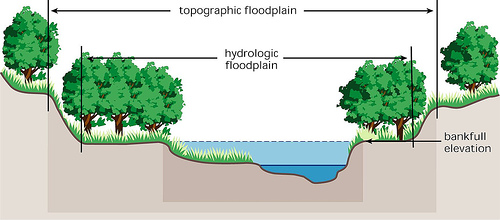Flooding in Wisconsin
Last week, residents of southern Wisconsin experienced the first flash flood warnings of 2016. Flash floods are not prolific in Wisconsin, but they can be detrimental and have been in the past. One of the most significant floods in Wisconsin in recent years was in 2008. This flood caused 40,000 homes and 5,000 businesses to become severely damaged in southern Wisconsin. The total damage was estimated to cost more than $1.2 billion (http://www.floodsafety.noaa.gov/states/wi-flood.shtml). Although severe floods are not common in Wisconsin, flooding is common in southern Wisconsin due to the topography.
Madison, Wisconsin - and many cities around it – are located near lakes. Lakes are located in low topographic land and they receive all of the watershed from the rivers, streams, and creeks around it. When it rains, rainfall travels from the ground to the rivers, streams, creeks, etc, to the lakes in the lowland. Wisconsin has an average of 30.89 inches of rainfall per year; this is not a drastic amount in comparison to rainy states such as Florida, whom receives 49.91 inches per year. However, there is still risk for flooding and those who live near lakes in South Central Wisconsin are at a greater risk than other residents of Wisconsin. (if you don’t believe me see here).

Plan for Flooding
Steps to take when it floods
The most obvious reason why flooding is devastating to many families is because it damages their home. During a flood, it is important to get to higher ground because more than likely flooding will occur in a basement. Purchasing flood insurance is important and having a plan before flooding actually happens is even more important. Moving your valuables, furniture, and important documents to a safe place is suggested by the government and needs to be done before valuables are ruined from water.

After flooding has occurred, getting the water out of your house and making sure your valuables have not been harmed should be your number one priority. Basement flooding is typical and, unfortunately, basements are used often for a place to store an individuals possessions. Moving all of the items out of your basement can be a pain and finding a place to put them while a professional drains your basement is even more cumbersome. That is why finding temporary storage is a must after flooding.

There are many steps one must take after a flood and you can find out what to do from a government sponsored website. Preventing mold growth in your house should be your number one priority during and after a flood, I explain how mold grows and how to prevent it in this blog. Utilizing temporary storage for valuables while you clean the problem should also be on your agenda. Cleaning and drying your items before you store them is important because it will prevent mold growth on your possessions and decrease the risk for further damage.

Takeaway Message
People have to deal with flooded basements from time to time, especially those of us who live in south central Wisconsin. Due to south central Wisconsin’s low topography, those living near the four lakes surrounding Madison are at a greater risk than other Wisconsin residents for flooding. Planning before a flood is crucial to make it a less painful process once flooding has begun. It can be a somewhat long process and making sure you keep an accurate account of your possessions is the most important step during flooding. Moving your items quickly to a temporary storage unit would make the process much easier. Trying to cram your items in a humid garage, which is inevitable in Wisconsin summers, it not always best for your valuables (it causes mold growth). We want to help you deal with this problem and make sure that this disaster can be less disastrous. You can rent a storage unit for as long as you need it. See here for temporary storage options.

